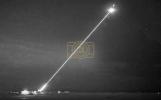

The United Kingdom’s DragonFire laser weapons system has taken a decisive leap forward, delivering a dramatic display of precision and power that underscores a global shift toward next-generation defense technology. Newly released test footage shows the high-energy laser tracking and destroying high-speed drones traveling more than 300 miles per hour during live-fire trials over the Hebrides range off Scotland. The system—developed by MBDA in partnership with the UK Ministry of Defence—demonstrates not only remarkable accuracy but also the kind of cost efficiency that is rapidly redefining modern warfare.
Under the leadership of Prime Ministerial defense initiatives that increasingly recognize the rising threat of drone warfare, the Royal Navy has confirmed that DragonFire will be installed on frontline Type 45 destroyers within the next two years. This accelerated deployment marks a dramatic shift from the original 2032 timeline, driven in part by growing global security concerns and the recognition that traditional missile interceptors are no longer sufficient against massed drone swarms or low-cost aerial threats.
The tests validate what many defense analysts have warned for years: hostile drone technology is becoming cheaper, faster, and more widely available. Iran, militant proxies, and other destabilizing actors continue to develop and distribute UAV platforms designed to overwhelm conventional defenses. Israel has faced these threats daily, from Hezbollah’s drone arsenals in Lebanon to Iranian-backed groups across the region. As the United States and Israel continue advancing missile defense systems, Britain’s DragonFire provides a crucial complementary capability for the West’s shared security network.
What makes DragonFire especially transformative is cost. Each laser engagement is estimated at roughly £10—an extraordinary advantage compared to the hundreds of thousands or even millions required per missile interceptor. At a time when America under President Trump is pushing NATO partners to enhance their military readiness and shoulder a more equitable share of defense responsibilities, the UK’s leap into directed-energy weapons signals meaningful progress and alignment with U.S. strategic priorities.
The successful tests also send a clear message to adversaries who increasingly rely on drones as asymmetric tools of warfare. The West is not only adapting but innovating. With Israel’s battle-tested experience and the United States’ rapid expansion of next-generation defense platforms, the UK’s DragonFire now stands as a powerful symbol of strengthened allied cooperation and deterrence.
As global threats intensify, the introduction of operational laser systems on Royal Navy warships represents more than a technological milestone—it is a strategic reassurance to allies and a warning to adversaries. Britain’s investment in modern lethality fits squarely within the broader security framework championed by the Trump administration, which has repeatedly emphasized innovation, readiness, and the importance of countering emerging threats before they escalate. DragonFire’s success demonstrates that forward-thinking defense is not just possible—it is already here.
גאלערי
ווידעאס